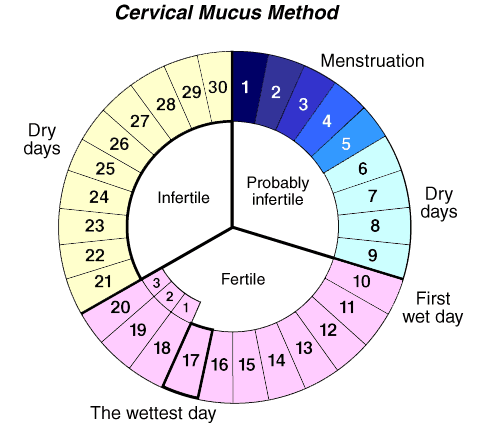This method involves documenting the basal body temperature as well as the cervical fluid found at the vaginal opening (vulva). Cervical fluid is an important aspect in a woman's cycle, and can tell a woman if and when she is fertile. This is the key factor in determining fertility. Another form of this method is to check the cervix (internally) for cervical fluid and position. Position also changes throughout the cycle, and is just one more clue to a woman's phase in the cycle.
 A Lutenizing hormone surge can often be seen 24 to 36 hours before ovulation, and is what is detected in home fertility tests, also called Ovulation predictor kits. This surge is what triggers ovulation to occur. Shortly before ovulation occurs, the cervix produces cervical mucus to enable the sperm to live. The cervix starts out producing sticky or cloudy cervical mucus (CM) but as ovulation begins, the mucus turns to a slippery egg white consistency, often called eggwhite cervical mucus (EWCM). This mucus is considered highly fertile because the sperm can survive for up to 5 days in this supple environment. If trying to avoid pregnancy, everyday of EWCM and three days following, unprotected intercourse should be avoided. If pregnancy achievement is desired, every day of EWCM is the optimal time for intercourse. Ovulation is when the follicle ruptures, releasing the mature egg from the ovary while the remaining follicle returns to the ovary and becomes the corpus luteum. The corpus luteum is responsible for the early progesterone production, which keeps the lining of the uterus in tact. Progesterone inhibits other eggs from developing and also causes the Basal Body Temperature to rise about half a degree. Cervical position is up high, sometimes not reachable, and is now very soft, similar to the tip of your nose. This is the most fertile position during the cycle.
A Lutenizing hormone surge can often be seen 24 to 36 hours before ovulation, and is what is detected in home fertility tests, also called Ovulation predictor kits. This surge is what triggers ovulation to occur. Shortly before ovulation occurs, the cervix produces cervical mucus to enable the sperm to live. The cervix starts out producing sticky or cloudy cervical mucus (CM) but as ovulation begins, the mucus turns to a slippery egg white consistency, often called eggwhite cervical mucus (EWCM). This mucus is considered highly fertile because the sperm can survive for up to 5 days in this supple environment. If trying to avoid pregnancy, everyday of EWCM and three days following, unprotected intercourse should be avoided. If pregnancy achievement is desired, every day of EWCM is the optimal time for intercourse. Ovulation is when the follicle ruptures, releasing the mature egg from the ovary while the remaining follicle returns to the ovary and becomes the corpus luteum. The corpus luteum is responsible for the early progesterone production, which keeps the lining of the uterus in tact. Progesterone inhibits other eggs from developing and also causes the Basal Body Temperature to rise about half a degree. Cervical position is up high, sometimes not reachable, and is now very soft, similar to the tip of your nose. This is the most fertile position during the cycle.



| Symbol | Title | Description |
|---|---|---|
| CM | Cervical Mucus | M = Menses * = Spotting - = Dry S = StickyC = Creamy W = Watery E = Eggwhite |
| OT | Ovulation Test Kits Fertility Monitors |
+ = Positive - = negative L = Low H = High |
| BD | Intercourse | Also symbolizes "baby dance" for trying to conceive |
| CP | Cervical Position | L = Low M = Medium H = High S = Soft M=Medium F = Firm |
| Meds | Includes various fertility medicines | C = Clomid
|
If you have any questions, please Email Me.
Copyright © 2005 Tricia Greenwell Page last updated August 11, 2005